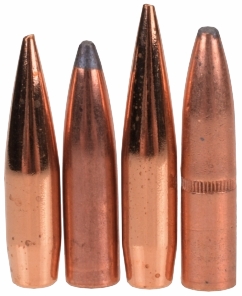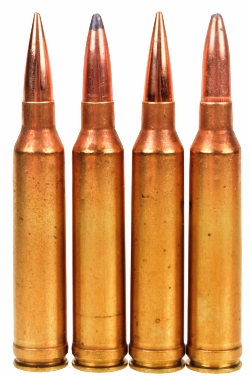
The 7mm Remington Magnum is a natural fit for the 26″ barrel Winchester Model 70 Extreme Weather SS. A commercial round since 1962, a wildcat even longer, it is capable of flat shooting, long reach and hard hitting depending on bullet selection and powder charge. While the Remington Magnum is an old timer, modern technology is changing its look.
Norma PH 7mm Remington Magnum 125 Grain Kalahari hollow point ammunition would seem very light for medium size game, but it was specifically created for antelope and deer hunting. With a muzzle velocity of 3350 fps it has a point blank range of approximately 311 yards, at 400 yards theoretical drop is only 12.5″. At 500 yards the round is still making 1038 ft-lbs of energy and traveling just about 2,000 fps. Not a round for me, I am not a light bullet 7mm mag proponent, but an interesting factory product.
Hornady is one of the middle ground bullet weight sources with ammunition like its 139 grain Superformance SST. 3240 fps MV and much improved B.C. and sectional density, this ammunition can hit a lot harder close in than the Norma ammo, and deliver the Norma’s 500 yard ballistics at 600 yards.
Remington Hypersonic 160 Grain Core-Lokt Ultra Bonded at 3002 fps is a heavy hitter in muzzle energy and has a point blank range only 11 yards shorter than the lightest weight highest velocity factory ammo and moved the long range high performance out to approximately 800 yards.
Double Tap ammo bumps 175 grain load performance at the muzzle to 2900 fps and 3268 ft-lbs. Longer range performance is about the same at 160 grain. The thing this bullet weight does is generate a lot of momentum for penetration in large game close in and farther out.
The ammunition noted is not a recommendation, just an indication of the range of ammunition that is available. There are currently sixty one types of mainstream factory ammunition loaded for the 7mm Remington Magnum, most of which is readily available within a wide range of prices.
For the handloader, there are over 100 types of 0.284″ bullets in weight ranges from 100 grains to 180 grains. Most will work well with the 7mm Remington Magnum, but not all. Bullet made for the 7mm-08 Rem and 7x57mm Mauser may be too thin jacketed for the high velocity magnum. However, bullet manufacturers make very clear recommendations, making bullet selection a relatively straight forward process.
Four of my favorites
The bullets selected are for hunting applications. Flat base bullets tend to be more accurate inside a few hundred yards and they tend to leave greater net case capacity. Unfortunately, flat base versions of a given bullet weight tend to have a lower ballistic coefficient, which shows up as reduced retained velocity. Of the four bullets selected, two are flat base; 160 and 175 grain and two are boat tail with a Very Low Drag ogive.

Berger bullets work well for medium game, especially at a distance. They are slippery, stable and jacketed to expand 12″ to 15″. The 160 grain Speer bullets are a bit tougher with tapered jacket for controlled expansion, but they are better inside 300 yards. The 175 grain Core-Lokt is a tough bullet that penetrates well in big and dangerous game and is still relatively flat shooting.
| Bullet | Weight Grains |
Type | Bullet B.C. |
Bullet Length |
COL |
| Berger VLD Hunting 28503 | 140 | VLDBT | 0.510 | 1.270 | 3.290 |
| Speer 1635 | 160 | SPFB | 0.519 | 1.240 | 3.280 |
| Berger VLD Hunting 28501 | 168 | VLDBT | 0.617 | 1.425 | 3.290 |
| Remington Core-Lokt 22919 | 175 | SPFB | 0.436 | 1.305 | 3.280 |
The cost of 7mm bullets is wide ranging. The Remington bullet runs 35 cents per, the Speer bullet runs about 30 cents. The Berger bullets 52 cents per. For the hunter, the cost difference is of no consequence. For the recreational target shooter who spends a lot of time between seasons keeping up and building proficiency, the cost can quickly become significant. Both Sierra and Hornady produce a quality, wide range of 7mm bullets are excellent prices, 22 cents to 33 cents. Nosler Partition, Speer Grand Slam and Swift A frame are no doubt the toughest bullets for big and dangerous game hunting; 61 cents, 31 cents, 57 cents respectively.

There are five primary companies producing brass for the 7mm Remington Magnum: Hornady, Norma, Nosler, Remington, Winchester. The brass within this project was all new Remington brass, but I would sub any other on the list. Lately I’ve read some derogatory reviews of Norma brass, citing things that are true of all new brass as thought it was a unique failure… shorter than spec cases or weights that vary from one case to another to minor degrees as though that was a defect.
I’ve been using Norma brass for a very long time and I use it frequently these days, along with the others listed. I’ve always found Norma to produce superior brass. By suspicion is that the negative reviews are written by inexperienced handloaders who are attempting to appear knowledgeable by seeing something no one else has ever seen. I’ll stick with what I know.
There is no magic in preparing and loading 7mm Remington Magnum brass, so special tools required. Just following the basic tenets of handloading should result in good ammunition that produces accurate results. Powder selection is routine, faster for lighter bullets, slower for heavy grain bullets seems to work well.
 |
Warning: Bullet selections are specific, and loads are not valid with substitutions of different bullets of the same weight. Variations in bullet material and length will alter net case capacity, pressure and velocity results. Primer selection is specific and primer types are not interchangeable. These data represents maximum loads in our firearms and test equipment and may easily be excessive in other applications. All loads should be reduced by 5%, and developed following safe handloading practices as represented in established reloading manuals produced by component manufacturers. Presentation of these loads does not constitute a solicitation for their use, nor a recommendation.
|
|||||||||||||||||||||||||||||||||||||||||||||||||||||||||||||||||||||||||||||
|
|
||||||||||||||||||||||||||||||||||||||||||||||||||||||||||||||||||||||||||||||
|
Berger 168 Grain 300 Yard Point Blank Range |
|||||||||||
|
Range – Yards |
0 |
50 |
100 |
150 |
200 |
250 |
300 |
350 |
400 |
450 |
500 |
|
Velocity – fps |
2952 |
2878 |
2804 |
2732 |
2662 |
2592 |
2523 |
2456 |
2389 |
2324 |
2259 |
|
Energy -ft.-lbs. |
3250 |
3089 |
2934 |
2785 |
2642 |
2505 |
2374 |
2249 |
2129 |
2014 |
1904 |
|
Momentum -lbs-sec |
2.19 |
2.14 |
2.08 |
2.03 |
1.98 |
1.93 |
1.88 |
1.83 |
1.78 |
1.73 |
1.68 |
|
Path – in. |
-1.5 |
1.1 |
2.6 |
3.0 |
2.2 |
0.2 |
-3.0 |
-7.7 |
-13.8 |
-21.4 |
-30.6 |
The Berger 168 grain outperforms the Remington 175 grain at 300 yards and beyond, but the Remington has 11 more yards point blank range. The 140 grain Berger for medium size game may be the best of all with only 24″ of drop at 500 yards and still moving 2363 fps and carrying 1736 ft-lbs of kinetic energy. The 140 grain’s point blank range is 324 yards.
Back to the Winchester Model 70 Extreme Weather SS
Every firearm design distinguishes itself in one manner or another. In the case of the Winchester Model 70 Extreme Weather SS, I would have to say it would be its effortless cycling; chambering and ejecting. A couple of times I found myself chamber checking, thinking the rifle had not stripped a round from the magazine. Both times I was wrong, the rifle had functioned perfectly.

The Winchester Model 70 is relatively easy to shoot, even when chambered for the 7mm Remington Magnum. I often hear or read the comments that the 280 Remington is virtually the same as the 7mm Remington Magnum, which is always worth a chuckle. The 7mm Mag is a serious cartridge with hard hitting capability and heavy bullets performance levels the 280 Remington could not approach. Overall, the rifle and cartridge make a great combination, one that is enough for any North American game.

Email Notification